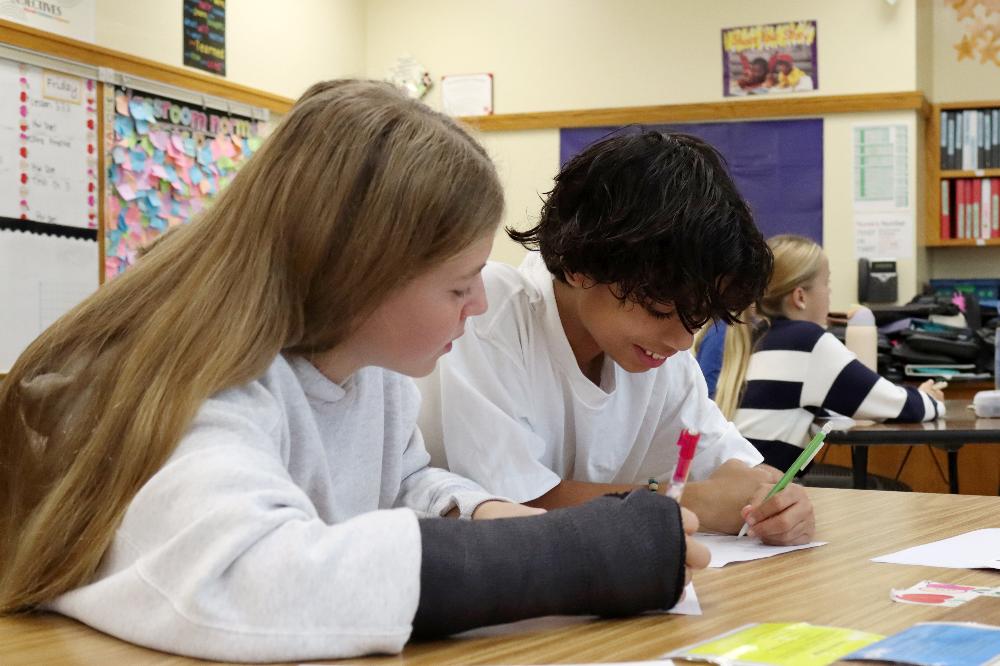Irving students increase math skills with innovative activity
November 25, 2025
Irving Middle School students unlocked mathematical doors this fall by solving escape room puzzles in their classrooms.
Dozens of Aardvarks increased their knowledge of polynomials, fractions and decimal-based division with an activity that produced shouts of joy. Students worked in teams to find numerical codes for many math-based riddles and equations. They then used the answers to advance to the next level of the escape room challenge.
Elise, Teddy, Annelise and Max celebrated when they discovered one of the answers after calculating an algebra problem on graph paper. They said it was exciting to sharpen their math skills together.
“My favorite part of the escape room is getting to work with a group,” Annelise said. “Because it’s really fun to be able to not work alone so I, like, don’t feel alone. I get to work with my friends.”
“I’d definitely recommend it, because it’s more fun than reviewing just normally for a test,” Max said. “It can help because if you don’t get something, people will explain it to you, and it’s nice. It’s more people and perspectives.”
Irving math teachers Ana Solano Becerra and Cody Liss said the escape room idea had become a winning strategy for both students and teachers. Pound Middle School teacher April Schermann shared her self-created puzzle with other members of her math tenure group earlier this semester, and Solano Becerra and Liss felt it would be worthwhile to try it in their classes. Student engagement levels and academic outcomes from Irving’s first activity were sky-high, which encouraged Solano Becerra and Lewis to write their own escape room storyline.
“Some of my students do not like math at all,” Liss said. “They would rather sit in detention than do math sometimes, actually. But I saw so much movement, so much work, so many questions coming out of it that I was like, ‘I think this would be a really good thing to do again.’”

Solano Becerra and Liss created an escape room puzzle that required students to review math items for an upcoming test. Each part of the challenge focused on core math concepts such as exponents, slope or constant numbers. They had to decipher clues that gave them the necessary parts of an equation to unlock either a three-digit or four-digit code.
After solving the equation for the story problem, the Aardvarks shared the code with Solano Becerra and Liss to move on to the next task. They continued the process until they successfully completed the final chapter.
Solano Becerra said one of the advantages of the escape room idea is that it has given her a chance to measure the progress of everyone in class. If a student is reluctant to help find the answer to a particular problem, it may mean they need more assistance with decimals or distributive properties. If everyone is pitching in, it shows that all team members are confident in their math abilities.
“I think it’s a great way for teachers just to be like, ‘Okay, who am I actually seeing contributing a lot to the team?’ versus ‘Who do I think I need to touch base with more before the test comes?’” Solano Becerra said.

Solano Becerra and Liss said they have also watched the Aardvarks develop lifelong talents from participating in escape room activities. Students must read directions carefully and encourage each other to find the right answers. This helps them realize how everyone can benefit from teamwork and mutual respect.
“They’re working on communication with each other, and not just being like, ‘This is the way to go,’” Solano Becerra said. “It’s a huge communication piece that we’re really working on also to be able to continue to work together and build together.”
Elise said she was proud of her group for joining forces on the project. They remained respectful to one another throughout the class period, and they applauded each time they solved one of the brainteasers.
“I feel it’s more interesting because you’re not doing it by yourself and not just being stressed by yourself,” Elise said.
“It’s also kind of like a backup,” Max said. “If you’re like, ‘Is this right?’ and then they can explain it. It helps a lot.”
The competition angle has also helped students reach their academic goals. The young mathematicians are aware when teams at other tables unlock a puzzle, and this motivates them to concentrate more on solving the clue at hand.
“You see the excitement of them in their group, and then they go on to the next one,” Liss said. “I’ll announce that we have a group going on to lock two, so it gets the other groups going. They want to pick up the pace and make sure they’re on task.”
“It’s really interactive, and it’s a fun way to learn because there’s, like, a goal and a reward to it,” Elise said.
All four Aardvarks said they would enjoy studying for future math exams in an escape room format. They felt the idea was helping them multiply their math knowledge and form friendships at the same time.
“It doesn’t feel like you’re reviewing for a test, which makes it more fun,” Annelise said.
LPS math teachers are using many innovative ideas to help students learn in their classes. Discover more about the LPS math curriculum and how it leads to successful academic outcomes at home.lps.org/math.
Do you have a story idea? Share it with the LPS Communications Team by filling out this form!
Published: November 25, 2025, Updated: November 26, 2025

Irving Middle School students compile answers to an escape room puzzle in Ana Solano Becerra's math class this fall. Solano Becerra and Cody Liss created an escape room activity to help the Aardvarks prepare for a math test. They reviewed subjects such as polynomials, fractions and decimal-based division and worked on communication and teamwork skills during the activity.





